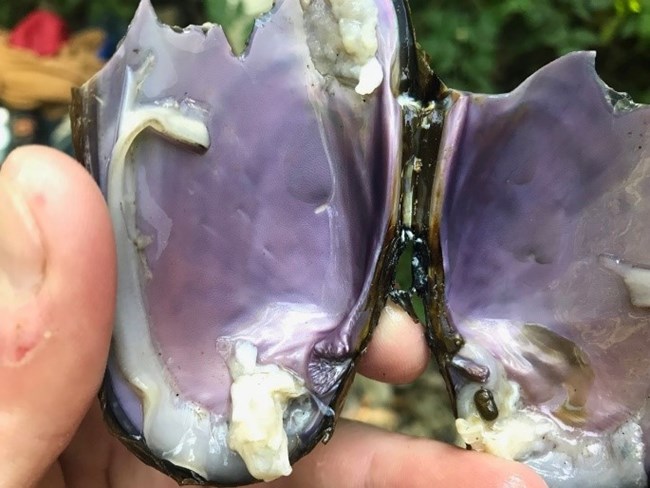Last updated: April 24, 2023
Article
Western Pearlshell

USFWS/Roger Tabor
General Description
Anchored into the ground, a hard brown organism points toward the sun. Etched into the outside, rings radiate in concentric circles, chronicling each year of age, almost 100 years old. It stretches up to almost 13 cm tall. It’s not a tree, but a mollusk.
The western pearlshell (Margaritifera falcata) is a freshwater mussel in the family Margaritiferidae. And while the outside may have passing similarities to a tree, the inside is a purple, pink, or white mother-of-pearl color, enclosing soft muscular body parts. Like all mussels, the western pearlshell has two hinged shells, or valves, that enclose its body, which includes a hatchet-shaped foot that can extend outside the valves.
Behavior and Feeding
Freshwater mussels are sedentary, meaning they rarely move. Throughout their lives (which average 60 to 70 years, one of the longest-lived animals on Earth), they may only move a couple of meters from where they first settled. Adult pearlshells can use their foot to dig into surrounding sediment and move short distances laterally or to burrow vertically, which is more common. Movement is often a response to physical disturbances, like changes in stream flow.
The western pearlshells’ sedentary lifestyle prevents them from traveling for food. They require water that has a constant flow of food and oxygen. Western pearlshells filter-feed, which involves opening their valves and using a siphon, a tube-like structure, to filter suspended organic particles. They can filter up to 50 liters of water every day! The particles they consume include plankton, bacteria, and algae. Not only does filtering particles out of the water provide food, it also improves the stream’s water quality by reducing turbidity (cloudiness) and nutrient levels.

NPS/Patrick Graves
Habitat and Distribution
Western pearlshells have the broadest distribution of any freshwater mussel species in the western US: from Alaska south to the Pacific Northwest and east to Montana, Wyoming, and Utah. They prefer to live in cold-water creeks and rivers. While juveniles and some adult pearlshells live completely buried in the sediment at the bottom of streams, only uncovering their siphon to filter food, most leave the upper part of their bodies exposed to open water.
Protection and stability are important components of a good habitat for western pearlshells. Areas behind large boulders make particularly good homes because the boulders provide protection from floods. Gravel stream bottoms are also ideal because gravel provides more stability than sand, silt, or mud.
Breeding and Reproduction
When a western pearlshell is around 9 to 12 years old, it reaches sexual maturity. During breeding, the male expels sperm into the water. While feeding, the female filters sperm from the water, a process that fertilizes the eggs. After a few weeks, the fertilized eggs develop into larvae, called “glochidia.” Fish— mainly salmonids, a group that includes salmon and trout—inhale these glochidia, and the glochidia become attached to the fish’s gills. Although these glochidia are parasitic, scientists believe that they do not harm their host fish. Once the glochidia are grown, which can take weeks to months, they drop off the fish and settle onto the bottom of the stream, where they grow into adult pearlshells.
Environmental Indicators
Western pearlshells are excellent indicators of stream health. Because this species is sedentary, scientists can mark study areas and return to them year after year to monitor the same group of pearlshells; scientists can then see how this group has changed over time as a response to environmental factors. Another reason they make good indicators is that their filter-feeding lifestyle makes them prone to bioaccumulation, or increases in the concentration of a chemical over time relative to the chemical’s concentration in the environment. Their long lifespans provide time for chemicals to accumulate in the pearlshells’ bodies. As a result of this bioaccumulation, scientists can use pearlshells to study the kinds of contaminants present in the water. All of these qualities make western pearlshells useful for assessing the health of ecosystems.
Fun Facts
-
Areas with abundant resources can support high densities of western pearlshells: more than 350 per square meter!
-
During breeding, the female western pearlshell releases 1–4,000,000 glochidia into the water!
-
Although a rare trait, scientists have found western pearlshell hermaphrodites, individuals that have both male and female reproductive traits and are capable of self-fertilization. They are one of only four North American mussel species with hermaphrodites.
Where to See
You can find western pearlshells in Redwood National and State Parks.
Learn More
-
https://wdfw.wa.gov/species-habitats/species/margaritifera-falcata#desc-range
- https://www.fws.gov/species/western-pearlshell-margaritifera-falcata
Download a pdf of this article.

Prepared by Jeri Stoller, Scientists in Parks intern
NPS Klamath Inventory & Monitoring Network
Southern Oregon University
1250 Siskiyou Blvd
Ashland, OR 97520
Featured Creature Edition: April 2023
